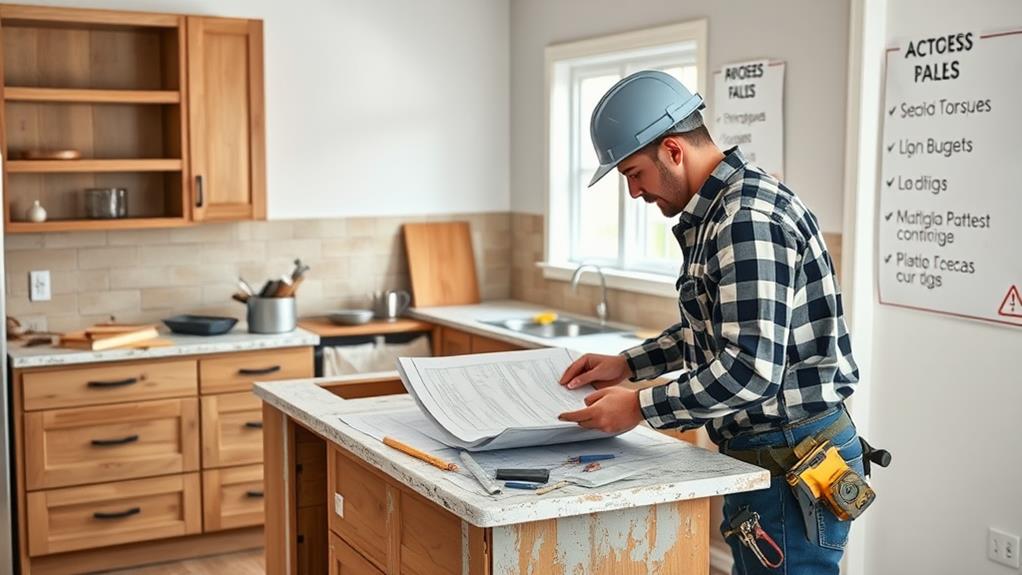Effective cash flow management during a home renovation project involves meticulous planning and financial oversight. Start by creating a detailed budget that accounts for all potential expenses, including a contingency fund for unexpected costs. Set up a dedicated account to track renovation-related transactions and prevent overspending. Prioritize your project phases, focusing on essential repairs before cosmetic upgrades. Negotiate favorable payment terms with contractors, opting for progress payments and retention clauses. Build in a 10-20% contingency fund to address unforeseen issues or design adjustments. By implementing these strategies, homeowners can maintain financial control throughout their renovation journey. Discover additional tips to ensure a smooth and successful transformation of your living space.
Create a Detailed Budget

The cornerstone of successful home renovation cash flow management is creating a detailed budget. This comprehensive financial plan should encompass all aspects of your project, from materials and labor to permits and unexpected contingencies.
Begin by researching costs for each element of your renovation, obtaining multiple quotes from contractors, and pricing out materials. Include line items for demolition, structural work, electrical, plumbing, HVAC, finishes, and appliances.
Factor in a contingency fund of 10-20% to cover unforeseen expenses or changes in scope. Be realistic about your timeline and how it may impact cash flow, considering potential delays or seasonal factors. Break down your budget into phases if you're tackling a large-scale renovation, allowing for better cash management throughout the project.
Don't forget to account for temporary living arrangements if necessary, as well as costs for storage, cleanup, and post-renovation touches like window treatments or furniture. Regularly review and update your budget as the project progresses, tracking actual expenses against projected costs. This meticulous approach to budgeting will help you maintain control over your renovation's cash flow and avoid financial surprises along the way.
Set Up a Dedicated Account
With a detailed budget in hand, the next step in managing your home renovation cash flow is to set up a dedicated account for the project. This separate account serves multiple purposes, all aimed at improving financial organization and control throughout the renovation process.
Firstly, a dedicated account allows for clear tracking of all renovation-related expenses. By keeping these transactions separate from your regular finances, you can easily monitor spending against your budget and identify any discrepancies or unexpected costs. This isolation also simplifies record-keeping for tax purposes or potential resale value calculations.
Secondly, it helps prevent overspending by clearly delineating renovation funds from personal finances. You're less likely to dip into renovation money for unrelated expenses, and vice versa. Many banks offer specialized renovation accounts with features like higher interest rates or flexible withdrawal options, which can be advantageous for managing larger sums over extended periods.
Lastly, a dedicated account facilitates smoother transactions with contractors and suppliers. It provides a clear paper trail for payments and can streamline the process of disbursing funds as different project phases are completed.
Prioritize and Phase Your Project

Prioritizing and phasing your renovation project is a crucial step in managing cash flow effectively. Begin by assessing your renovation goals and ranking them in order of importance. Consider which improvements will add the most value to your home or significantly enhance your quality of life.
Once you've established priorities, break down your project into manageable phases. Start with essential repairs and structural improvements before moving on to cosmetic upgrades. This approach ensures that your home remains functional throughout the renovation process and allows you to distribute costs over time. Create a timeline for each phase, factoring in seasonal considerations and potential delays.
Negotiate Payment Terms With Contractors
After establishing your renovation priorities and phases, negotiating payment terms with contractors becomes a key factor in managing your project's cash flow. Start by discussing payment schedules with potential contractors during the bidding process. Aim for a structure that aligns with project milestones rather than upfront lump sums.
A common approach is the "progress payment" method, where you pay in installments as specific stages of work are completed. This protects you from paying for unfinished work and incentivizes contractors to meet deadlines. Typically, an initial deposit of 10-30% is reasonable, followed by payments at predetermined intervals.
Negotiate a retention clause, withholding 5-10% of the total contract value until project completion. This ensures contractors address any outstanding issues promptly. Discuss payment methods, opting for traceable options like checks or bank transfers. Avoid cash payments, which can complicate record-keeping and dispute resolution.
Ensure all payment terms are clearly outlined in the contract, including conditions for final payment. By negotiating favorable terms, you can better manage your cash flow and maintain leverage throughout the renovation process.
Build in a Contingency Fund

A contingency fund serves as a financial safety net for your home renovation project. It's a dedicated amount set aside to cover unexpected costs or changes that may arise during the renovation process. Experts typically recommend allocating 10-20% of your total project budget for contingencies, depending on the scope and complexity of the work.
This fund can be crucial for addressing unforeseen issues such as structural problems, code compliance upgrades, or necessary material substitutions. It also provides flexibility to make design adjustments or incorporate additional features as the project progresses. Without a contingency fund, unexpected expenses could derail your renovation timeline or force you to compromise on quality.
To establish an effective contingency fund, assess your project's risk factors, such as the age of your home, the extent of structural changes, and the likelihood of encountering hidden problems. Consider setting up a separate savings account for this fund to ensure the money remains accessible yet distinct from your primary renovation budget. Regularly review and adjust your contingency allocation as the project advances, reallocating unused funds to other aspects of the renovation if necessary.
Track Expenses Meticulously
Meticulous expense tracking forms the backbone of successful financial management in home renovations. By maintaining a detailed record of every expenditure, homeowners can accurately monitor their budget, identify potential cost overruns, and make informed decisions throughout the project.
To effectively track expenses, create a comprehensive spreadsheet or use specialized renovation budgeting software. Categorize costs by type, such as materials, labor, permits, and equipment rentals. Record each transaction promptly, including the date, vendor, description, and amount. Keep all receipts, invoices, and contracts organized and easily accessible for reference and verification.
Regularly reconcile your tracked expenses against your bank statements and credit card bills to ensure accuracy. This practice helps catch any discrepancies or unauthorized charges. Additionally, compare actual costs to your initial budget estimates, allowing you to identify areas where you may need to adjust spending or reallocate funds.
Explore Financing Options

Exploring financing options opens up a world of possibilities for homeowners undertaking renovation projects. Various avenues exist to fund your home improvements, each with its own advantages and considerations.
Home equity loans and lines of credit (HELOCs) are popular choices, allowing you to borrow against your home's value. These often offer lower interest rates compared to personal loans or credit cards.
Cash-out refinancing is another option, replacing your existing mortgage with a larger one and providing the difference in cash.
For energy-efficient upgrades, consider specialized loans like the FHA's Energy Efficient Mortgage or PACE financing. Government-backed renovation loans, such as the FHA 203(k) or Fannie Mae HomeStyle, can be attractive for more extensive projects.
Personal loans and credit cards may be suitable for smaller renovations, though they typically come with higher interest rates. Some contractors offer financing plans, which can be convenient but should be carefully evaluated.
Before committing to any financing option, compare interest rates, terms, and fees. Consider your long-term financial goals and ability to repay. Consulting with a financial advisor can help you make an informed decision that aligns with your overall financial strategy.
Frequently Asked Questions
How Can I Save Money on Materials Without Compromising Quality?
To save money on materials without compromising quality, consider purchasing during sales, comparing prices across suppliers, buying in bulk, exploring salvage yards, and opting for alternative materials that offer similar performance at lower costs. Prioritize essential elements for optimal value.
Should I Consider DIY for Any Parts of the Renovation?
DIY can be cost-effective for certain aspects of renovation, particularly for simpler tasks like painting or minor repairs. However, complex or specialized work should be left to professionals to ensure quality, safety, and compliance with building codes.
How Do I Handle Unexpected Costs That Exceed My Contingency Fund?
When unexpected costs exceed your contingency fund, consider prioritizing essential work, negotiating with contractors, exploring alternative financing options, or temporarily pausing non-critical aspects of the renovation. Consult with your project manager to identify potential cost-saving measures or budget adjustments.
What Are the Tax Implications of a Home Renovation Project?
Tax implications of home renovations vary based on the project type. Generally, improvements that increase your home's value may be tax-deductible when selling. Energy-efficient upgrades might qualify for tax credits. Consult a tax professional for specific advice on your situation.
How Can I Protect Myself From Contractor Fraud or Subpar Work?
While no method is foolproof, you can protect yourself from contractor fraud or subpar work by:
- Researching contractors thoroughly
- Obtaining multiple bids
- Checking licenses and insurance
- Getting detailed contracts
- Monitoring progress closely
- Withholding final payment until satisfied
Conclusion
Effective cash flow management is the cornerstone of successful home renovations. While meticulous budgeting and expense tracking provide structure, flexibility through phased projects and contingency funds offers adaptability. Balancing the precision of dedicated accounts with the fluidity of negotiated payment terms ensures financial stability. As homeowners navigate the complex landscape of renovation finances, exploring diverse funding options becomes crucial. Ultimately, the interplay between rigorous planning and strategic financial maneuvers transforms ambitious renovation dreams into tangible, beautifully executed realities.

